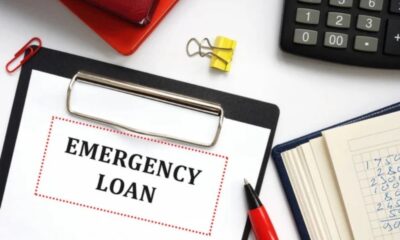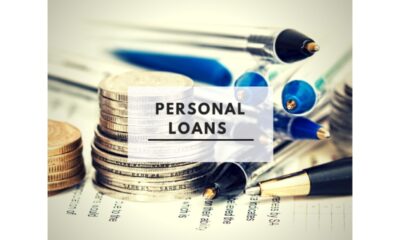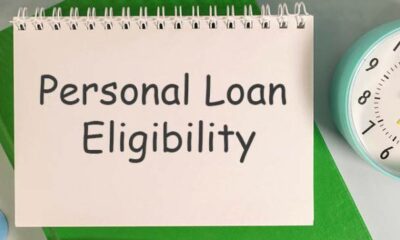Business
How To Obtain A Personal Loan With Poor Credit and Additional Factors

Obtaining a personal loan with poor credit could necessitate taking additional measures to demonstrate your ability to repay the amount. Low credit scores are interpreted by lenders as an indication of past credit management difficulties. To mitigate this risk, they typically impose higher annual percentage rates (APRs) and costs, and offer smaller loan amounts that need quicker repayment than loans from companies with fair or excellent credit.
If your credit score is low, your best bet for getting a personal loan is to know what you need for approval, shop about, and compare offers.
Obtaining A Loan When Having Poor Credit
Any credit score lower than 580 is regarded by most lenders as bad credit. But, some lenders may have a negative credit minimum of less than 670, so be sure to verify the lender’s requirements. You may better prepare for the process by being aware of the requirements for obtaining a personal loan, whether you’re supporting an emergency or paying off high-interest credit cards.
1. Verify Your Credit Records and Score
The primary determinant of the rate you will pay for a personal loan is your credit score. The usual range of rates for personal loans is 6 to 36 percent. You are more likely to receive an offer of a rate of thirty percent or more if your score is lower.
Your bank or credit card issuer can provide you with a free peek at one or all three of your credit scores if you haven’t recently reviewed your ratings. Get your free credit reports from AnnualCreditReport.com if they’re lower than anticipated. According to federal law, you have the right to a free copy of your credit report from Equifax, Experian, and TransUnion—the three main credit reporting agencies—once a year.
Before you apply for a personal loan, check your report for mistakes or past debt that is lowering your score. If so, take steps to have them fixed.
2. Examine Your Earnings and Outstanding Debts
Lenders who specialize in bad credit give special consideration to whether you have steady enough income to repay a new personal loan. They’ll calculate how much of your monthly income goes toward debt repayment. This is referred to as your debt-to-income (DTI) ratio by lenders, and each lender has a different ceiling.
Be cautious: Pay attention to the tiny print if the lender states that loans with DTI percentages up to 50% can be approved. Based on your credit score, you may only be eligible for a lesser DTI ratio as that ceiling may only apply to borrowers with better ratings. If your DTI ratio is higher than allowed when you apply, the lender can instead offer you a smaller loan amount.
You’ll probably need to show that you have a steady source of income from a full-time hourly work or salary in order to get accepted if you have low credit. Unreliable earnings from commissions, tips, or self-employment might not be accepted by a lender who has hard credit.
3. Determine Your Monthly Payment Choices
If you’re used to paying the minimal amount due on your credit cards, the monthly payment on a personal loan for bad credit could be substantially greater than you had anticipated. Check if the monthly payment on your personal loan fits within your budget by using a personal loan calculator.
To obtain a true estimate of what you would pay, make sure you enter the greatest interest rate you can; otherwise, the calculator might come pre-filled with a lesser rate than you’ll be eligible for. Select a term of three to five years, even when the lender offers alternatives for payments that last seven years. Generally speaking, borrowers with better credit scores are given longer durations.
4. Examine Lenders For Bad Credit
You should apply to at least three different lenders and compare their rates and fees because the terms for bad credit lenders can change significantly across them. Check to see if your local bank or credit union offers any rate breaks or charge reductions for personal loans with poor credit.
For applicants with poor credit, online personal loan providers might provide the most possibilities. Certain companies apply less stringent requirements for clearance than traditional banks, like your employment and educational background. When evaluating lenders, look up information on their website or get in touch with them regarding:
- Minimal ratings for credit. Depending on the lender, the minimum could be as high as 670 or as low as 500.
- Ranges of loan amounts. For loans under $2,500, several lenders provide attractive solutions. Bad credit lenders often cap your loan amount at $50,000 or less, while some personal loan providers offer sums as high as $100,000.
- Repayment terms. Term lengths for loans with bad credit often range from one to five years. For the lowest payment, go for a longer term. Although some lenders might provide a longer term for a smaller loan amount, you’ll likely be limited to five years.
5. Obtain Preapproval
You can view your eligibility odds and anticipated rates by prequalifying without affecting your credit score. Most lenders offer this free tool, which can help you get an idea of what a competitive rate might look like for you. When you’re done comparing lenders, get prequalified with three or more of them.
Your credit scores are unaffected by this process, which should only include a mild credit pull.
6. If Required, include a Co-borrower or Co-signer
Check to see if the lender lets you add a co-signer or co-borrower to increase the amount of your loan if you are unable to become prequalified for the amount you require. A creditworthy friend or relative who agrees to assume equal responsibility for the loan but does not have access to the funds is known as a co-signer.
Similar to a co-signer, but with access to the money you borrow, is a co-borrower. If you decide to include someone else in your loan request, proceed with caution. If you are unable to repay the loan, they will be held responsible and your failure to make payments will negatively impact their credit.
Together with your co-signer, come up with a repayment strategy before you sign, and be sure to communicate clearly when making payments.
7. Compile Financial Records
Personal loans often simply need a small number of financial records to be approved. To get your application for a personal loan with bad credit accepted, you might need to submit additional documentation. This could include W-2s from previous years, tax returns, and bank records that indicate the location of your paycheck deposits.
When you apply, you could be required to submit some or all of the following:
- Personal information, such as address, full name, and Social Security number.
- Your driver’s license or similar identity document that was issued by the government.
- Personal loan data, like why you need the loan, how much you need and how long of a term you desire.
- W-2 statements over the previous two years.
- Your previous two years’ federal tax returns.
- The two most current bank account statements combined.
- Recent paystubs.
- Mortgage statements or utility bills (to confirm your address).
To ensure that the financing procedure proceeds without hiccups, promptly provide any additional demands. Before sending the documents, make sure they are readable; lenders will reject anything that is difficult to read or fuzzy.
8. Get Ready for A Rigorous Credit Inquiry
Upon selecting the lender of your choice, you will formally submit an application for a personal loan. A hard pull, or credit check, will be done by the lender. Your credit score will temporarily drop a few points as a result of a hard draw.
The slight negative impact a hard check has on your credit score can be mitigated by a few months of on-time payments. Nevertheless, if you do an excessive number of hard inquiries quickly, your credit report may suffer long-term harm. This may appear to lenders like you’re applying for several loans or items you can’t afford, which could be interpreted as a risk.
If you must submit to more than one hard credit inquiry, try to do it within 45 days to avoid damaging your credit. The most recent FICO scoring model states that if you apply for the same kind of product more than once in a 45-day period, your credit report will show several hard check inquiries as a single query.
9. Receive Funds for Your Personal Loan with Bad Credit
The lender can fund your loan in as little as one business day after you submit your documentation. Usually, money is deposited straight into your bank account. You might be able to pay off your creditors immediately if you decide to take out a debt consolidation loan from some providers.
The majority of lenders provide autopay, which deducts your monthly payment on the due date from your bank account. An additional benefit: If you set up an automated payment, you can be given a discounted rate or fewer costs.
Things To Think About Before Applying for A Bad Credit Loan
With time, a personal loan for bad credit could be a very useful instrument for streamlining your finances and raising your credit scores. Having said that, before making a final choice, consider the disadvantages of include a fixed monthly payment in your budget.
Higher Interest Rates Will Be Incurred
You will pay more in interest when applying for a loan with a low credit score than when you have a higher credit score, which is a sad fact. The charges, though, can be less than what you would pay for credit cards that are fully charged. The majority of loans for people with bad credit are used to settle credit card debt, which can raise your credit scores.
This is so because your credit utilization ratio—a gauge of how much of your available credit you’re using—is directly impacted by paying off outstanding credit card debt. Your credit scores may rise noticeably, enabling you to switch from a high-rate bad credit loan to a low-rate good credit loan.
The Cost of Loans Is Higher
Up to 10% of the loan amount may be charged in fees for loans with bad credit. Since these costs are deducted from your loan balance, you will have less money available for emergencies, home repairs, and debt consolidation.
Be wary of unscrupulous lenders who want payment in full before granting you credit. The proceeds from your loan should be used to cover all costs. If a company asks you to pay upfront fees for any loan you take out with bad credit, you should flee, not walk away.
It’s Possible That Your Loan Amount Will Be Less
The maximum loan amount that lenders who provide personal loans for people with poor credit often allow is $50,000. If your credit score is extremely low (below 580) or your debt-to-income ratio is high, the amount can be much smaller.
In General, Terms Are Shorter
A poor credit score indicates to a lender that you could have previously struggled with managing your credit. Consequently, they might prefer that you pledge to repay the loan over a period of three to five years as opposed to the six or seven years they could grant a borrower with strong or exceptional credit.
The good news is that you can refinance to a longer-term personal loan in the future and use the savings to pay off your loan balance faster if your credit score rises over time.
Where To Apply for Loans With Valid Bad Credit
Banks, credit unions, and online lenders all offer personal loans. To get competitors to fight for your business, you may also consider using online marketplace lenders. Examine internet reviews and personal loan lender reviews to find out what other borrowers with poor credit have to say about the firm.
Don’t Take These Shady Loans with Bad Credit
Predatory lenders offering payday or auto title loans are more likely to target borrowers with poor credit. These are frequently marketed as “no credit check” loans, which implies that no credit check is required to be approved. After acceptance, the loan funds are often available one business day later, with very little paperwork needed.
However, with APRs as high as 650 percent, they frequently need to be paid off quickly, which forces many borrowers to take on more debt than they can afford. Steer clear of payday loans, auto title loans, and no credit check installment loans if at all possible.
Payday Loans
A valid paycheck as evidence is all that is required to be eligible for a payday loan up to $500. The caveat is that you have to deduct the remaining amount from your next paycheck, along with lender fees, which can cost you anywhere from $10 to $30 for every $100 you borrow.
These are frequently used by customers for necessities like food, rent, or utility payments. Payday borrowers frequently extend or renew payday loans numerous times because of the fast repayment schedule, which provides little room for unforeseen events. Payday lending harms borrowers who are living paycheck to paycheck, which is why many states outlaw it or place strong restrictions on it.
Installment Loans With No Credit Check
In order to get their entire loan amount at once, borrowers who require larger loan amounts than payday lenders are willing to grant may select this kind of loan. Although you usually have a few months to years to repay this kind of loan, they can still be expensive because the interest rates can reach triple digits.
Title Loans for Cars
With an auto title loan, you can use your automobile as collateral to borrow against the equity if you own a vehicle free of liens. This kind of loan has an APR that often ranges from 300 to 400%. An auto title lender has the right to seize your vehicle and sell it to cover the amount you owe if you don’t make payments.
-

 Sports4 weeks ago
Sports4 weeks agoFIFA Club World Cup 2025: Complete List of Qualified Teams and Groups
-

 Sports3 weeks ago
Sports3 weeks agoAl Ahly vs Inter Miami, 2025 FIFA Club World Cup – Preview, Prediction, Predicted Lineups and How to Watch
-
Health1 week ago
Back to Roots: Ayurveda Offers Natural Cure for Common Hair Woes
-

 Tech2 weeks ago
Tech2 weeks agoFrom Soil to Silicon: The Rise of Agriculture AI and Drone Innovations in 2025
-

 Sports3 weeks ago
Sports3 weeks agoFIVB Men’s Volleyball Nations League 2025: Full Schedule, Fixtures, Format, Teams, Pools and How to Watch
-

 Startup3 weeks ago
Startup3 weeks agoHow Instagram Is Driving Global Social Media Marketing Trends
-

 Television4 weeks ago
Television4 weeks agoTribeca Festival 2025: Date, Time, Lineups, Performances, Tickets and How to Watch
-

 Sports3 weeks ago
Sports3 weeks agoWorld Judo Championships 2025: Full Schedule, Date, Time, Key Athletes and How to Watch























